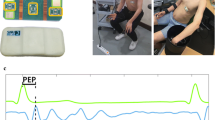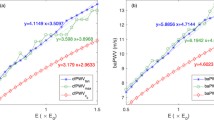Abstract
Objective
The aim of this study was to compare beat-to-beat changes in stroke volume (SV) estimated by two different pressure wave analysis techniques during orthostatic stress testing: pulse contour analysis and Modelflow,ie, simulation of a three-element model of aortic input impedance.
Methods
A reduction in SV was introduced in eight healthy young men (mean age, 25; range, 19–32 y) by a 30-minute head-up tilt maneuver. Intrabrachial and noninvasive finger pressure were monitored simultaneously. Beat-to-beat changes in SV were estimated from intrabrachial pressure by pulse contour analysis and Modelflow. In addition, the relative differences in Modelflow SV obtained from intrabrachial pressure and noninvasive finger pressure were assessed.
Results
Beat-to-beat changes in Modelflow SV from intrabrachial pressure were comparable with pluse contour measures. The relative difference between the two methods amounted to 0.1±1% (mean±SEM) and was not dependent on the duration of tilt. The diference between Modelflow apoplied to intrabrachial pressure and finger pressure amounted to −2.7±1.3% (p=0.04). This difference was not dependent on the duration of tilt or level of arterial pressure.
Conclusions
Based on different mathematical models of the human arterial system, pulse contour and Modelflow compute similar changes in SV from intrabrachial pressure during orthostatic stress testing in young healthy men. The magnitude of the differnece in SV derived from intrabrachial and finger pressure may vary among subjects; Modelflow SV from noninvasive finger pressure tracks fast and brisk changes in SV derived from intrabrachial pressure.
Similar content being viewed by others
References
Benditt DG, Ferguson DW, Grubb BP, et al. Tilt table testing for assessing syncope. American College of Cardiology.J Am Coll Cardiol 1996; 28:263–275.
Smit AAJ, Wieling W, Karemaker JM. Clinical approach to cardiovascular reflex testing.Clin Sci 1996; 91(Suppl):108–112.
Stevens PM. Cardiovascular dynamics during orthostasis and the influence of intravascular instrumentation.Am J Cardiol 1996; 17:211–218.
Smith JJ, Ebert J. General response to orthostatic stress. In: Smith JJ, Ed.Circulatory Response to the Upright Posture. Boca Raton, FL: CRC Press; 1990:1–46.
Imholz BPM, Wieling W, Van Montfrans GA, et al., Fifteen years experience with finger arterial pressure monitoring: assessment of the technology.Cardiovasc Res 1998; 38:605–616.
Jellema WT, Imholz BPM, Van Goudoever J, et al. Finger arterial versus intrabrachial pressure and continuous cardiac output during head-up tilt testing in healthy subjects.Clin Sci 1996; 91:193–200.
Petersen ME, Williams TR, Sutton R. A comparison of non-invasive continuous finger blood pressure measurement (Finapres) with intra-arterial pressure during prolonged head-up tilt.Eur Heart J 1995; 16:1641–1654.
Smith JJ, Bush JE, Wiedmeier VT, et al. Application of impedance cardiography to study of postural stress.J Appl Physiol 1970; 29:133–137.
McDonald DA.Blood flow in arteries. London: Arnold; 1974:420–445.
Marik PE, Pendelton JE, Smith R. A comparison of hemodynamic parameters derived from transthoracic electrical bioimpedance with those parameters obtained by thermodilution and ventricular angiography.Crit Care Med 1997; 25:1545–1550.
Langewouters GJ, Wesseling KH, Geodhard WJA. The static elastic properties of 45 human thoracic and 20 abdominal aortas in vitro and the parameters of a new model.J Biomech 1984; 17:425–535.
Wesseling KH, Jansen JRC, Settels JJ, et al. Computation of aortic flow from pressure in humans using a nonlinear, three-element model.J Appl Physiol 1993; 74:2566–2573.
Peñáz J. Photoelectric measurement of blood pressure, volume and flow in the finger. Dresden: Digest of the International Conference on Medicine and Biological Engineering (abstract) 1973;104.
Wesseling KH, De Wit B, Van der Hoeven GMA, et al. Physiocal, calibrating finger vascular physiology for Finapres.Homeostasis 1995; 36:67–82.
Wesseling KH, De Wit B, Weber JAP, et al. A simple device for the continuous measurement of cardiac output.Adv Cardiovasc Physics 1983; 5–11:16–52.
Jansen JRC, Wesseling KH, Settels JJ, et al. Continous cardiac output monitoring by pulse contour during cardiac surgery.Eur Heart J 1990; 11(Suppl):26–32.
Stok WJ, Baisch F, Hillebrecht A, et al. Noninvasive cardiac output measurement by arterial pulse analysis compared with inert gas rebreathing.J Appl Physiol 1993; 74:2687–2693.
Westerhof N, Elzinga G, Sipkema P, An artificial arterial system for pumping hearts.J Appl Physiol 1971; 31:776–781.
Burkhoff D, Alexander JJ, Schipke J. Assessment of Windkessel as a model of aortic input impedance.Am J Physiol 1988; 255:H742-H753.
Jellema WT, Wesseling KH, Groeneveld ABJ, et al. Continuous cardiac output in septic shock by simulating a model of the aortic input impedance. A comparison with bolus injection thermodilution.Anesthesiology 1999; 90:1317–1328.
Hirschl MM, Binder M, Gwechenberger M, et al. Noninvasiva assessment of cardiac output in critically ill patients by analysis of the finger blood pressure waveform.Crit Care Med 1997; 25:1909–1914.
Harms MPM, Wesseling KH, Pott F,et al. Continuous stroke volume by modelling flow from non-invasive arterial pressure in humans under orthostatic stress.Clin Sci 1999, in press.
Bos WJW, Van Goudoever J, Van Montfrans GA, et al. Reconstruction of brachial artery pressure from non-invasive finger pressure measurements.Circulation 1996; 94:1870–1875.
Voogel AJ, Bos WJW, Van Goudoever J, Van Montfrans GA, Wesseling KH. Finger-to-brachial comparability of “Modelflow” stroke volume improves after pulsewave reconstruction.Clin Physiol 1997; 17:327–337.
Ward A.Sequential Analysis. New York: John Wiley and Sons; 1947.
Sprangers RLH, Wesseling KH, Imholz ALT, et al. Initial blood pressure fall on stand up and exercise explained by changes in total peripheral resistance.J Appl Physiol 1991; 70:523–530.
O'Rourke MF, Blazek JV, Moreels CL, et al. Pressure wave transmission along the human aorta; changes with age and in arterial degenerative disease.Circ Res 1955; 3:623–631.
Imholz BPM, Wieling W, Van Montfrans GA, et al. Fifteen years experience with finger arterial pressure monitoring: assessment of the technology.Cardiovasc Res 1998; 38:605–616.
Bos WJW, Imholz BPM, Van Goudoever J, et al. The reliability of noninvasive continous finger blood pressure measurement in patients with both hypertension and vascular disease.Am J Hypertens 1992; 5:529–535.
Karamanoglu M, O'Rourke MF, Avolio AP, et al. An analysis of the relationship between central aortic and peripheral upper limb pressure waves in man.Eur Heart J 1993; 14:160–167.
Espersen K, Jensen EW, Rosenborg D, et al. Comparison of cardiac output measurement techniques: thermodilution, Doppler, CO2-rebreathing and the direct Fick method.Acta Anaesthesiol Scand 1995; 39:245–251.
Eriksen M, Walloe L. Improved method for cardiac output determination in man using ultrasound Doppler technique.Med Biol Eng Comput. 1990; 28:555–560.
Schondorf R, Cameli L, Benoit J, et al. Comparison of pulse contour and impedance cardiograph measurements of stroke volume and cardiac output during head-up tilt (abstract).Clin Autonom Res 1997; 7:265.
Van Lieshout EJ, Toska K, Eriksen M, et al. Non-invasive continuous cardiac stroke volume monitoring: evaluation of a novel technique.Neth J Med 1998; 52:A44 (Abstract).
Author information
Authors and Affiliations
Corresponding author
Rights and permissions
About this article
Cite this article
Jellema, W.T., Imholz, B.P.M., Oosting, H. et al. Estimation of beat-to-beat changes in stroke volume from arterial pressure: A comparison of two pressure wave analysis techniques during head-up tilt testing in young, healthy men. Clinical Autonomic Research 9, 185–192 (1999). https://doi.org/10.1007/BF02330482
Received:
Accepted:
Issue Date:
DOI: https://doi.org/10.1007/BF02330482




